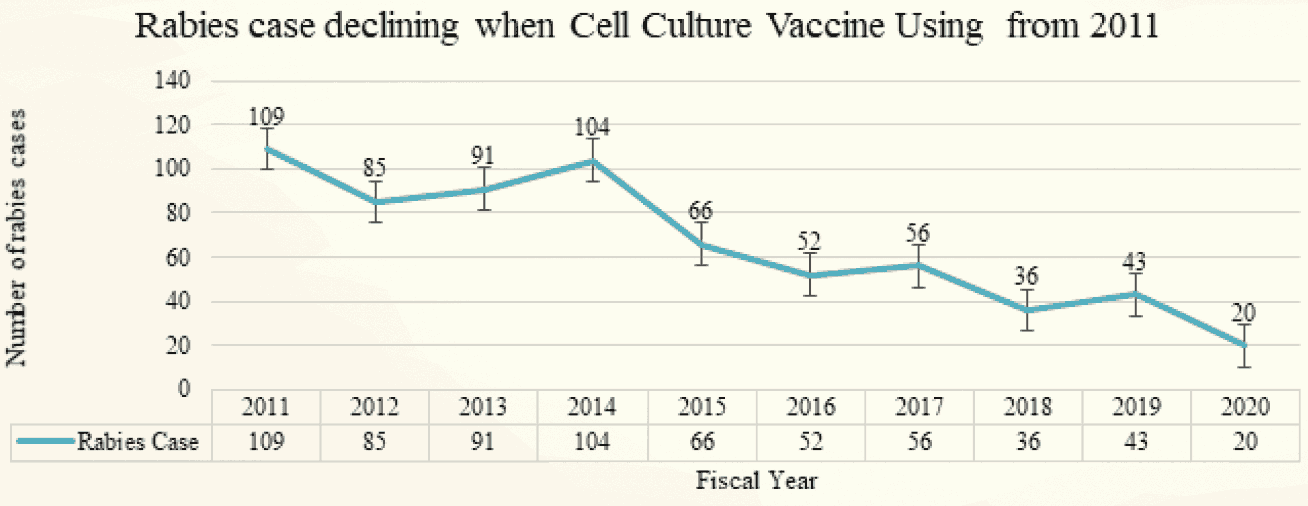1. Introduction
exp date isn't null, but text field is
Rabies is a fatal viral disease. Globally, every year many people and livestock die of this disease and so is also Bangladesh is ranked third in the world list for rabies infection. Since 2010, the Government of Bangladesh has priorities the ‘Rabies Control’ as an important program. A joint initiative of the Ministry of Health and Family Welfare, Ministry of Fisheries and Livestock and Ministry of Local Government and Rural Development started ‘Rabies Control’ activities from 2011 and prepared a ‘National Strategy Paper’ on rabies control and developed a roadmap for its implementation by 2023 with the commitment to ‘Rabies free Bangladesh’. The Communicable Disease Control (CDC) under the Directorate General of Health Services (DGHS) is working diligently to implement this roadmap and moving forward to eliminate rabies from Bangladesh by 2030. In pursuance of this, with the achievement of the UN-approved Sustainable Development Goals (SDGs) 3.3, the DGHS has been continuing its efforts under the ‘National Rabies Elimination Program’ in 2010 of the Zoonotic Disease Control Program. Strategies adopted for successful implementation of rabies elimination program includes:
- Advocacy, Communication and Social Mobilization (ACSM)
- Animal Bite Management (ABM)
- Mass Dog Vaccination (MDV)
- Dog Population Management (DPM)
- Surveillance and Research
In 2013, the Technical Working Group and the National Steering Committee were formed to provide technical and ethical support from the highest level of government for the immediate and successful implementation of these strategies. CDC has set up one ‘National Rabies Prevention and Control Center’ (NRPCC) at Infectious Disease Hospital (IDH) at Mohakhali, Dhaka and 64 ‘District Rabies Prevention and Control Center’ (DRPCC) at all District Sadar Hospitals as well as one in Bangladesh Institute of Tropical and Infectious Disease at Chittagong and 105 ‘Upazila Rabies Prevention and Control Center’ (URPCC) at Upazila Health Complex to Ensure modern management of animal (dog, cat, fox, mongoose, monkey etc.) bite victims by washing the affected area, with soap and running water for 15 minutes and Anti-Rabies Vaccine (3-times in 7-days, 6 doses with regimen of ‘2-2-2-0-0’)1 provided by well-trained health care providers. The use of Rabies Immunoglobulin (RIG) administration is determined according to the category of exposure (category III). Physicians, staff nurses, EPI technicians, statisticians, storekeepers, health inspectors, assistant health inspectors and many more officers and employees of all District Sadar Hospitals and Upazila Health Complexes across the country are trained. They can provide modern medical management to the clients after scratch/bite of dogs and other animals.
Significant progress has been made last 10 years after the start of the rabies control program with the active engagement of the Department of Livestock Services and Local Government and the initiative of the DGHS. The number of rabies-related deaths across the country is rapidly declining as the application of modern medical management has been expanded and used after the scratch/bite of dogs and other animals to prevent rabies in humans, led by the DGHS. In 2009, the number of human deaths due to rabies in Bangladesh was estimated at more than 2000. The number of deaths has gradually decreased to 26 in 2020 due to the adoption and effective implementation of the ‘National Rabies Elimination Program’ since 2010 with the start of the cell culture vaccine.

As per necessity for the ‘National Rabies Elimination Program’, the capacity of the Zoonotic Disease Control Program of the Disease Control Division of the DGHS has been strengthening many ways. This exceptional progress of the ‘National Rabies Elimination Program’ in Bangladesh in a short period has come a long way in building a rabies-free Bangladesh and this achievement is being welcomed and praised not only in our country but also in the regional and international arena.
In 2012, more than 120,000 patients were vaccinated free of cost, which increased to 25,361 in 201. In the fiscal year 2020-21, CDC provided 101 vaccinations to all District Sadar Hospitals, BITID Hospital, Chittagong and Infectious Disease Hospital Mohakhali. According to the Upazila Health Complex demand, Anti-Rabies Vaccine (ARV) and Rabies Immunoglobulin (RIG) are being provided as part of the Government of Bangladesh program. Dogs are the primary carriers of rabies in Bangladesh, more than 90%. Thus, it is possible to keep humans and other animals safe by preventing rabies in dogs. Countries and regions scientifically vaccinate 70 percent of dogs against rabies on a large scale, creating herd immunity. If three rounds of rabies vaccine are correctly given in the subsequent 3 years, it is possible to get rid of rabies in that area. In the light of this idea, from the beginning of the ‘National Rabies Elimination Program’ in Bangladesh, that is, from 2012-13, the Mass Dog vaccination program started, and it is still going on. With the active support and cooperation of the Department of Local Government, Directorate of Livestock Services and Zoonotic Disease Control Program under CDC about 21,37,739 dogs have been vaccinated against rabies under the 1st round in 64 districts, 2nd round in 16 districts and 3rd round in 6 districts.
